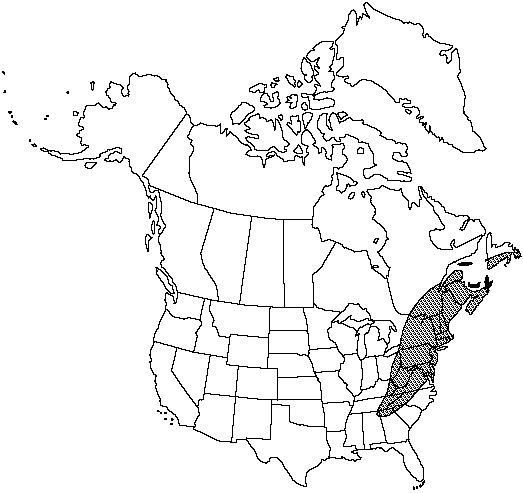Difference between revisions of "Polypodium appalachianum"
Amer. Fern J. 81: 18. 1991.
FNA>Volume Importer |
FNA>Volume Importer |
||
| Line 17: | Line 17: | ||
}}<!-- | }}<!-- | ||
| − | --><span class="statement" id="st- | + | --><span class="statement" id="st-undefined" data-properties=""><b>Stems </b>often whitish pruinose, slender, to 6 mm diam., acrid-tasting; scales concolored to weakly bicolored, uniformly golden brown or slightly darker near apex, lanceolate, contorted distally, margins denticulate. <b>Leaves</b> to 40 cm. <b>Petiole</b> slender, ± 1.5 mm diam. <b>Blade</b> elongate-deltate, rarely oblong, pinnatifid, usually widest at or near base, to 9 cm wide, herbaceous to somewhat leathery; rachis sparsely scaly to glabrescent abaxially, glabrous adaxially; scales lanceolate-ovate, usually more than 6 cells wide. <b>Segments</b> linear to oblong, less than 8 mm wide, margins entire to crenulate; apex acute to narrowly rounded; midrib glabrous adaxially. <b>Venation</b> free. <b>Sori</b> midway between margin and midrib to nearly marginal, less than 3 mm diam., circular when immature. <b>Sporangiasters</b> present, usually more than 40 per sorus, heads densely covered with glandular hairs. <b>Spores</b> less than 52 µm, verrucose, projections less than 3 µm tall. <b>2n</b> = 74.</span><!-- |
-->{{Treatment/Body | -->{{Treatment/Body | ||
| + | |phenology=Sporulating summer–fall. | ||
|habitat=Cliffs and rocky slopes, on a variety of substrates | |habitat=Cliffs and rocky slopes, on a variety of substrates | ||
|elevation=0–1800 m | |elevation=0–1800 m | ||
| Line 39: | Line 40: | ||
|basionyms= | |basionyms= | ||
|family=Polypodiaceae | |family=Polypodiaceae | ||
| + | |phenology=Sporulating summer–fall. | ||
|habitat=Cliffs and rocky slopes, on a variety of substrates | |habitat=Cliffs and rocky slopes, on a variety of substrates | ||
|elevation=0–1800 m | |elevation=0–1800 m | ||
| Line 46: | Line 48: | ||
|publication year=1991 | |publication year=1991 | ||
|special status= | |special status= | ||
| − | |source xml=https://jpend@bitbucket.org/aafc-mbb/fna- | + | |source xml=https://jpend@bitbucket.org/aafc-mbb/fna-data-curation.git/src/9216fc802291cd3df363fd52122300479582ede7/coarse_grained_fna_xml/V2/V2_623.xml |
|genus=Polypodium | |genus=Polypodium | ||
|species=Polypodium appalachianum | |species=Polypodium appalachianum | ||
| − | |||
| − | |||
| − | |||
| − | |||
| − | |||
| − | |||
| − | |||
| − | |||
| − | |||
| − | |||
| − | |||
| − | |||
| − | |||
| − | |||
| − | |||
| − | |||
| − | |||
| − | |||
| − | |||
| − | |||
| − | |||
| − | |||
| − | |||
| − | |||
| − | |||
| − | |||
| − | |||
| − | |||
| − | |||
| − | |||
| − | |||
}}<!-- | }}<!-- | ||
-->[[Category:Treatment]][[Category:Polypodium]] | -->[[Category:Treatment]][[Category:Polypodium]] | ||
Revision as of 14:24, 27 July 2019
Stems often whitish pruinose, slender, to 6 mm diam., acrid-tasting; scales concolored to weakly bicolored, uniformly golden brown or slightly darker near apex, lanceolate, contorted distally, margins denticulate. Leaves to 40 cm. Petiole slender, ± 1.5 mm diam. Blade elongate-deltate, rarely oblong, pinnatifid, usually widest at or near base, to 9 cm wide, herbaceous to somewhat leathery; rachis sparsely scaly to glabrescent abaxially, glabrous adaxially; scales lanceolate-ovate, usually more than 6 cells wide. Segments linear to oblong, less than 8 mm wide, margins entire to crenulate; apex acute to narrowly rounded; midrib glabrous adaxially. Venation free. Sori midway between margin and midrib to nearly marginal, less than 3 mm diam., circular when immature. Sporangiasters present, usually more than 40 per sorus, heads densely covered with glandular hairs. Spores less than 52 µm, verrucose, projections less than 3 µm tall. 2n = 74.
Phenology: Sporulating summer–fall.
Habitat: Cliffs and rocky slopes, on a variety of substrates
Elevation: 0–1800 m
Distribution

N.B., Nfld., N.S., Ont., P.E.I., Que., Ala., Conn., Del., D.C., Ga., Ky., Maine, Md., Mass., N.H., N.J., N.Y., N.C., Ohio, Pa., R.I., S.C., Tenn., Vt., Va., W.Va.
Discussion
Polypodium appalachianum is a newly recognized species traditionally identified as the diploid cytotype of P. virginianum (A. M. Evans 1971; I. Manton and M. Shivas 1953). Because the tetraploid cytotype is an allopolyploid (C. H. Haufler and Wang Z. R. 1991), and the type specimen of P. virginianum is tetraploid (R. Cranfill and D. M. Britton 1983), the diploid is recognized here as a distinct species, P. appalachianum. Some collections of P. appalachianum can be difficult to distinguish from P. virginianum, but the latter species has spores averaging more than 52 µm, and P. appalachianum has spores less than 52 µm. Frequent hybridization between P. appalachianum and P. virginianum forms morphologically intermediate, triploid individuals with misshapen spores. Particularly confusing is the frequent occurrence of the triploid sympatric with only one parent or with neither parent nearby.
Selected References
None.